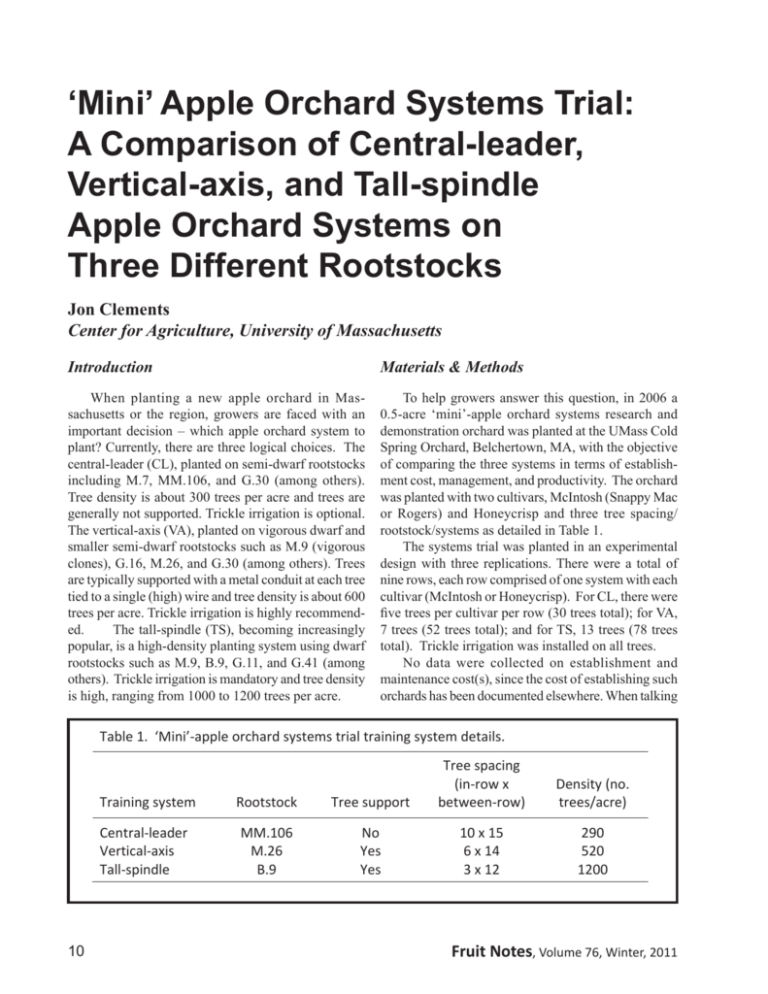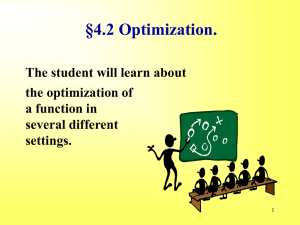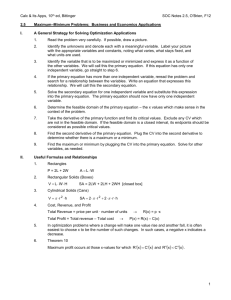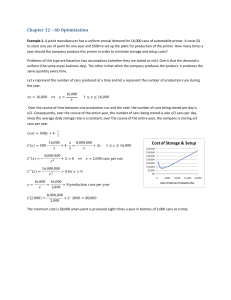'Mini' Apple Orchard System Trial
advertisement

‘Mini’ Apple Orchard Systems Trial: A Comparison of Central-leader, Vertical-axis, and Tall-spindle Apple Orchard Systems on Three Different Rootstocks Jon Clements Center for Agriculture, University of Massachusetts Introduction Materials & Methods When planting a new apple orchard in Massachusetts or the region, growers are faced with an important decision – which apple orchard system to plant? Currently, there are three logical choices. The central-leader (CL), planted on semi-dwarf rootstocks including M.7, MM.106, and G.30 (among others). Tree density is about 300 trees per acre and trees are generally not supported. Trickle irrigation is optional. The vertical-axis (VA), planted on vigorous dwarf and smaller semi-dwarf rootstocks such as M.9 (vigorous clones), G.16, M.26, and G.30 (among others). Trees are typically supported with a metal conduit at each tree tied to a single (high) wire and tree density is about 600 trees per acre. Trickle irrigation is highly recommended. The tall-spindle (TS), becoming increasingly popular, is a high-density planting system using dwarf rootstocks such as M.9, B.9, G.11, and G.41 (among others). Trickle irrigation is mandatory and tree density is high, ranging from 1000 to 1200 trees per acre. To help growers answer this question, in 2006 a 0.5-acre ‘mini’-apple orchard systems research and demonstration orchard was planted at the UMass Cold Spring Orchard, Belchertown, MA, with the objective of comparing the three systems in terms of establishment cost, management, and productivity. The orchard was planted with two cultivars, McIntosh (Snappy Mac or Rogers) and Honeycrisp and three tree spacing/ rootstock/systems as detailed in Table 1. The systems trial was planted in an experimental design with three replications. There were a total of nine rows, each row comprised of one system with each cultivar (McIntosh or Honeycrisp). For CL, there were five trees per cultivar per row (30 trees total); for VA, 7 trees (52 trees total); and for TS, 13 trees (78 trees total). Trickle irrigation was installed on all trees. No data were collected on establishment and maintenance cost(s), since the cost of establishing such orchards has been documented elsewhere. When talking Table1.‘Mini’Ͳappleorchardsystemstrialtrainingsystemdetails. Trainingsystem CentralͲleader VerticalͲaxis TallͲspindle 10 Rootstock Treesupport Treespacing (inͲrowx betweenͲrow) MM.106 M.26 B.9 No Yes Yes 10x15 6x14 3x12 290 520 1200 Density(no. trees/acre) Fruit Notes, Volume 76, Winter, 2011 with growers about the cost of establishing an orchard, I typically use a figure of $10 per tree multiplied by the number of trees per acre. The cost of trees is the overriding factor. Therefore, it is assumed the approximate cost per acre for establishing these three orchards is: CL, $2,900; VA, $5,200; and TS, $12,000. Ongoing maintenance and harvest costs generally increase as tree density increases (tree training and per-bushel harvest costs), however, the difference between orchard systems is not significant and beyond the scope of this study. In the early years, the high-density systems will take more time, but later, they become more labor-efficient than the lower-density orchards. Additional data collection has been minimal, consisting of yield beginning in 2008 (3rd leaf) and continuing in 2009 and 2010. Two methods were used for estimating yield per acre: in 2008, all fruit on each tree were counted after ‘June drop’ in mid-July, and assumed to average 100-count fruit per 40 pound box (0.4 pounds per fruit) at harvest in September. In 2009 and 2010, all fruit were picked and either weighed (2009) or put in bushel boxes or bins (2010) and total yield recorded. 2), Honeycrisp yielded more apples per acre in 2008; however, McIntosh yielded more in 2010. In 2009, they yielded the same. Cumulative yield was higher for McIntosh than Honeycrisp. Looking at rootstocks (i.e., system: TS, VA, or CL) only (Table 3), B.9 produced the highest yield per acre for all three years. M.26 and MM.106 did not differ in yield during the individual years; however, M.26 produced higher cumulative yield than MM.106. Remember that rootstock is confounded with system, i.e., B.9 is tall-spindle (TS), M.26 is vertical-axis (VA), and MM.106 is central-leader (CL). Therefore the tall-spindle system had the highest yield per acre across-the-board. Table 4 shows yield per acre by cultivar/rootstock (planting system) combination. In general, yield per acre did not differ by cultivar/rootstock combination except as described above for cultivar and rootstock individually. But, in 2010, yield of McIntosh/B.9 was significantly higher than Honeycrisp/B.9 (Figure 1). The same was true for cumulative yield (Figure 2). Results Overall, regardless of cultivar, the tall-spindle (TS) system planted on B.9 rootstock (Figure 3) had the highest cumulative yield of fruit during the 3rd, 4th, and Conclusion Comparing Honeycrisp to McIntosh only (Table Table2.Appleyield(40Ͳlbboxes/acre)bycultivarandyear. Cultivar Honeycrisp McIntosh 2008 2009 2010 Cumulative (2008Ͳ10) 111a 55b 138 238 831b 1070a 582b 777a Cultivarswithinyearnotfollowedbysameletteraresignificantlydifferent. Table3.Appleyield(40Ͳlbboxes/acre)byrootstockandyear. Rootstock B.9(TS) M.26(VA) MM.106(CL) 2008 2009 2010 Cumulative (2008Ͳ10) 140a 79b 29b 350a 121b 93b 1061a 596b 382b 1551a 796b 504c Rootstockswithinyearnotfollowedbysameletteraresignificantlydifferent. Fruit Notes, Volume 76, Winter, 2011 11 Table4.Appleyield(40Ͳlbboxes/acre)bycultivar/rootstockandyear. Cultivar/rootstock Honeycrisp/B.9(TS) Honeycrisp/M.26(VA) Honeycrisp/MM.106(CL) McIntosh/B.9(TS) McIntosh/M.26(VA) McIntosh/MM.106(CL) 2008 2009 2010 Cumulative (2008Ͳ10) 176 109 47 105 49 11 288 55 71 412 187 115 738 619 390 1385 574 373 1202 783 508 1902 810 499 Figure 1. Yield per acre (40-lb boxes/acre, 2010) for culƟvar by rootstock (planƟng system) combinaƟons. 5th seasons. In fact, cumulative yield was almost twice that of the vertical-axis system (Figure 4). Now, let us consider the estimated economics briefly by looking at estimated cost of establishment, cumulative yield at the end of the 5th leaf, and estimated gross return from the harvested apples, assuming a retail price of $40 per box (Table 5). Now, admittedly this economic analysis assumes 12 that fixed and variable operating costs per acre per year are the same, which is probably not altogether true, although I would contend it is not going to make a big difference in the final conclusion of this economic analysis. It also assumes that all of the yield is sold as top-quality fruit at retail. Although the cost of establishing the tall-spindle orchard seems high, the potential to make considerably Fruit Notes, Volume 76, Winter, 2011 more money in the early years and recover that return on investment is very high, assuming all goes well. This is why the number one proponent of the tall-spindle orchard in North America, Dr. Terence Robinson of Cornell University, is often espousing the tall-spindle apple orchard as “the way to fabulous riches” (Figure 5) for the progressive apple grower. Thanks to the Trustees of the Horticultural Research Center for the financial support to establish this research and demonstration planting and the staff of the UMass Cold Spring Orchard Research & Education Center for harvest help. Figure 2. CumulaƟve yield (40-lb boxes/acre, 2008-10) for culƟvar by rootstock (planƟng system) combinaƟons. Figure 4. VerƟcal-axis Snappy Mac McIntosh tree on M.26 rootstock, September 2010. Figure 3. Tall-spindle Honeycrisp apple tree on B.9 rootstock, September 2010. Figure 5. The tall-spindle apple orchard is “the way to fabulous riches.” Fruit Notes, Volume 76, Winter, 2011 13 14 Fruit Notes, Volume 76, Winter, 2011 Fruit Notes, Volume 76, Winter, 2011 15







